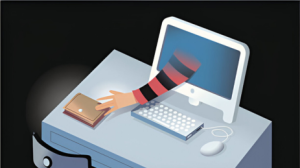Ever wondered how many clicks are actually seen by actual people while utilizing Pay Per Click (PPC) advertising or paying by ad impressions? Maybe you’ve heard of click fraud and are wondering what it is and how it operates. In this guide, we shall examine the development of digital marketing in detail. We’ll go over the click fraud definition in terms of cyber security, how it works, and how to prevent it.
What is click fraud?
Click fraud is a form of fraud in which traffic figures for online ads are inflated. Advertisers pay a charge for each click on their ad in the popular pay-per-click advertising model, hoping to attract a potential consumer.
The perpetrators of click fraud use automated clicking programs to make it appear as though a lot of potential consumers are clicking on the advertiser’s links, but in reality, it is doubtful that any of the clicks will result in revenue for the advertiser.
Click fraud is committed either to boost the revenue of an ad hosting website or to deplete the advertiser’s advertising budget. Click fraud is another tactic used by cybercriminals to elevate harmful websites in search results and give them a more authentic appearance.

How it works?
To achieve the intended result, fraudulent clicks must be generated in large quantities. While it is possible to manually create fraud clicks, fraudsters typically utilize automated systems to click a link several times.
Advanced click fraud schemes randomly interact with advertisements and other relevant content. The assaults imitate human behavior in this way, making it far more difficult for businesses or Internet service providers (ISPs) to identify them. Perpetrators use proxies, VPNs, or IP spoofing to conceal their identity and whereabouts in order to remain undetected.
The outcome? A company’s reputation is harmed, and data from digital advertising initiatives is unreliable.
A significant cybersecurity concern for businesses of all kinds worldwide is fraudulent clicks. Furthermore, scammers will not go anywhere anytime soon.
Factsheet
|
Types of Click Fraud
The following are the most prevalent forms of click fraud:
- Click farms
Large groups of people are compensated to click on links or advertisements by hand in manual click farms. An automated click farm software creates fake clicks by using networked machines running specialized programs to circumvent CAPTCHA security mechanisms.
- Click fraud botnets
Malware-infected devices can be utilized as a component of a botnet to produce fake clicks. Auto click bots are vast computer networks that a cybercriminal can remotely manipulate from a central location. Users frequently aren’t aware that their computer is a part of a botnet.
- Pixel stuffing
The practice of inserting a tiny ad link onto a 1×1 pixel on a webpage is sometimes referred to as “ad stuffing.” Any click in the region is, therefore, considered an interaction because the invisible ad is concealed in a larger frame.
- Competitor clicks
A company may purposefully plan and carry out a click fraud assault against a rival. The goal is to deplete the rival’s advertising budget, skew click-through rate statistics, and lower their search engine ranking.
- Geotargeting click fraud
Fraudsters can simulate clicks from particular geographic regions by using proxy servers or virtual private networks (VPNs). This can provide the impression that advertising initiatives are attracting real interest from target audiences. Data from display adverts can be further distorted by using location fraud to mimic interest in things that are unavailable in particular areas.
Identifying Click Fraud
-
IP Address Surveillance
Imagine yourself as an experienced investigator, tracking down a criminal by analyzing fingerprints. Likewise, monitoring IP addresses yields important hints. Keep an eye on the IPs that are driving clicks on your advertisements by using sophisticated analytics tools.
An unexpected spike in clicks from a remote place or a single IP persistently displaying your ads? These are the warning signs in the digital world!
-
Publisher Scrutiny
Not every website is a reliable ally in your advertising endeavors. Ads may be lured onto malicious publishers’ spam-filled pages by low-quality content. Examine high-traffic websites closely in the “placements” area of your platform’s advertisement. Is there something odd about a website? Remove it from your list of publishers.
-
The Click-Through Conundrum
At first, high click-through rates could seem like a good thing, but be careful. Something might be wrong if those ad clicks don’t result in purchases or conversions. Keep an eye out for differences between clicks and conversions, especially from unanticipated areas.
Are you getting a lot of clicks from a market that has nothing to do with your intended audience? There may be click fraud hiding beneath the surface.
-
Data Discrepancy Enigma
Pay close attention to your campaign data. Suspicion is aroused by sudden increases in impressions and a drop in page views. Keep an eye on important data like impressions, conversions, and ad clicks to spot irregularities that could point to fraud.
How to prevent click fraud?
-
Monitor user behavior
Determining if a person is engaging in click fraud can be aided by tracking the number of possibly suspicious clicks that originate from the same ISP.
-
Be Vigilant About Competitors
Businesses can detect click fraud by using click-tracking software to generate data that contain unique and total clicks.

-
Click Fraud Protection Software
Click fraud prevention software automatically blocks potentially harmful traffic sources while identifying possibly fraudulent or suspicious activities.
-
Make Referral Reports
These reports can assist in locating content-targeted websites that are bringing in an unusually high volume of visitors.
How To Stop Click Fraud?
It’s difficult to defend your advertising networks against click fraud and click spam. Many businesses opt to employ specialized click fraud detection technologies rather than investing internal resources in combating scammers.
You may prevent fraudulent and suspicious activities by using fraud-click blocker software, such as Ad Protect, from reliable suppliers. You can concentrate on your primary business functions rather than allocating resources to protect your organization from con artists.
Conclusion
By avoiding undesired traffic and using sophisticated automation to identify, prevent, and report any fraudulent activity in real time, the best click fraud protection systems in the business make sure your budget is as cost-effective and optimized as possible.
Therefore, by increasing conversions from genuine, authentic clicks, click fraud protection software may help you get the most out of your advertising budget, regardless of whether you are a business owner managing your ad campaigns or a marketing agency overseeing several client accounts.
FAQs
Why does click fraud occur?
Click fraud is mostly committed by cybercriminals to sabotage a competitor’s business or for financial gain.
How can I detect and protect my PPC campaigns from click fraud?
Use click fraud detection software to safeguard PPC advertisements and advertising networks by spotting questionable click patterns and offering real-time monitoring.
What impact does fraud have on a website?
Fraud eventually skews user data for advertisers and raises advertising costs while decreasing conversion rates.
Is It Safe To Click On Ads?
Before you click on advertisements, you should think twice. Hackers can trick users into installing malware or divulging their passwords by using adverts in search results that appear authentic.
click blocker click bots click fraud protection fraud clicks
Last modified: December 23, 2024


